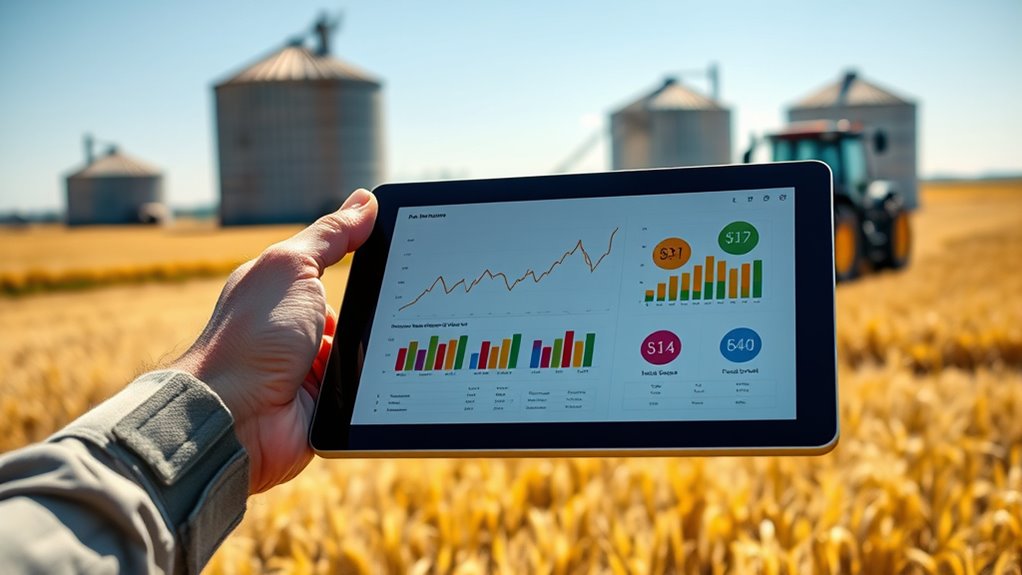To plan financially for grain price fluctuations, stay informed about market trends with daily updates, futures, and spot prices. Diversify your income streams, use crop insurance, and consider risk management tools like price hedging. Set clear goals, build a contingency fund, and keep operating expenses flexible. Regularly review your strategies and adjust based on new market data. Persistent monitoring and smart planning help protect your finances—continue exploring to learn more ways to stay resilient.
Key Takeaways
- Develop risk management strategies by monitoring market indicators, futures, and spot prices to anticipate and respond to price fluctuations promptly.
- Diversify revenue streams and maintain flexible operating expenses to mitigate risks during volatile grain markets.
- Set realistic financial goals and build contingency reserves covering 3-6 months of operating costs for market resilience.
- Utilize price hedging tools like futures, options, and forward contracts to lock in prices and stabilize income.
- Regularly review market conditions, update budgets, and adjust strategies to adapt to changing grain price dynamics.
Understanding Market Volatility and Its Impact

Understanding market volatility is essential because grain prices can change rapidly due to a variety of factors. You need to recognize that weather conditions, global supply and demand, and geopolitical events can all cause sudden price swings. Unexpected droughts or floods can reduce harvest yields, pushing prices higher unexpectedly. Conversely, bumper crops or new trade agreements may lead to sharp declines. Market sentiment and speculative trading also influence prices, sometimes causing fluctuations that seem disconnected from fundamentals. Staying informed about these variables helps you anticipate potential shifts. By understanding the causes of volatility, you can better assess risk and make more informed decisions. Recognizing how quickly prices can shift prepares you to react promptly, minimizing losses and maximizing opportunities in a volatile market. Additionally, market volatility can be influenced by external factors such as weather events and geopolitical tensions, which can rapidly alter supply expectations and pricing.
Developing a Diversified Revenue Strategy

To manage grain price fluctuations, you should consider creating multiple revenue streams to spread risk. Exploring crop insurance options can provide a safety net during downturns, while contract farming offers stable income opportunities. Combining these strategies helps guarantee your farm’s financial resilience in unpredictable markets. Additionally, staying informed about market trends and best practices can further improve your financial stability.
Multiple Revenue Streams
Diversifying your revenue streams is essential for weathering grain price fluctuations and maintaining financial stability. By not relying solely on crop sales, you reduce your vulnerability to market swings. Consider adding livestock sales, such as cattle or poultry, to generate income when grain prices dip. You might also explore agritourism, like farm tours or events, which can bring in steady cash flow. Renting out land for hunting or grazing offers additional income without extra work. Value-added products, such as processed grains or organic options, can boost returns and attract different customers. Each revenue source acts as a safety net, helping you manage unpredictable market conditions. Building multiple streams ensures you’re not overly dependent on one, giving you a more resilient financial foundation. Awareness of potential small mistakes can help you avoid costly errors that might threaten your diversification efforts.
Crop Insurance Options
Crop insurance plays a crucial role in safeguarding your farm’s income against unpredictable weather and market fluctuations. It provides a safety net that helps you manage risks and maintain financial stability during poor harvests or price drops. There are several crop insurance options available, such as Revenue Protection, which covers your expected revenue based on yield and prices, and Price Loss Coverage, which compensates for price declines. You can also consider Multi-Peril Crop Insurance, offering broader coverage against natural disasters like droughts and floods. Evaluating these options carefully allows you to choose coverage levels that align with your financial goals and risk tolerance. Having the right crop insurance in place ensures you stay resilient, even when grain prices swing unexpectedly. Perishable items require careful handling and timely delivery to maintain quality and minimize losses.
Contract Farming Advantages
Contract farming offers a strategic way to develop a diversified revenue stream, giving you access to guaranteed markets and prices. By entering into contracts, you secure a buyer before planting, reducing the risk of price drops or unsold produce. This arrangement provides predictable income, helping you manage cash flow more effectively. It also encourages better planning and resource allocation since you know your sales terms upfront. Additionally, contract farming can offer technical support, quality standards, and inputs at reduced costs, improving your overall productivity. This approach minimizes exposure to market volatility, allowing you to focus on efficient production. Ultimately, it creates a more stable income foundation, helping you withstand price fluctuations and build a resilient farm enterprise.
Setting Realistic Financial Goals and Budgets

Setting realistic financial goals and budgets is essential for managing the risks associated with grain price fluctuations. First, assess your current financial situation, including income, expenses, and savings. Set clear, achievable goals like covering operating costs, paying debts, or building savings, considering potential price swings. Develop a detailed budget that accounts for seasonal income variations and unpredictable market changes. Prioritize flexible spending plans that allow adjustments when prices fluctuate unexpectedly. Regularly review your financial targets and update your budget to reflect market trends and personal circumstances. Incorporating AI analytics can provide valuable insights into market patterns and help refine your financial strategies. By establishing practical goals and maintaining a disciplined budgeting process, you can better navigate market volatility, reduce stress, and ensure your farm’s long-term stability despite unpredictable grain prices.
Building a Contingency Reserve for Market Downturns

Building a contingency reserve is an essential step to protect your farm during market downturns. It provides a financial cushion so you can cover essential expenses when grain prices fall unexpectedly. To build this reserve, set aside a portion of your profits regularly, ideally during times of high prices. Keep your reserve liquid and easily accessible, such as in savings accounts or short-term investments. Aim to save enough to cover three to six months of operating costs, including inputs, labor, and loan payments. Review and adjust your reserve periodically based on changes in farm income and expenses. Having this safety net guarantees you can weather price slumps without resorting to costly loans or selling assets at a loss, keeping your farm financially resilient. Dynamic communication exercises can also enhance your ability to negotiate financial challenges effectively.
Using Price Hedging and Futures Contracts Effectively

Once you’ve established a financial cushion with a contingency reserve, you can take proactive steps to manage price risks more effectively. Using price hedging and futures contracts allows you to lock in prices before market fluctuations occur. To do this well, understand the futures market and choose contracts that match your production timeline and volume. When prices are high, consider selling futures to secure a sale price, protecting yourself if the market drops. Conversely, if prices are low, buy futures to set a minimum selling price for your grain. Always stay informed about market conditions and be prepared to close or adjust your positions as needed. Proper use of these tools can stabilize your income and reduce the impact of unpredictable price swings. Additionally, understanding market volatility can help you make better decisions when timing your hedging strategies.
Monitoring Market Trends and Price Indicators

To manage grain price fluctuations effectively, you need to stay alert to market trends and price indicators. Regularly track price movements to spot patterns, and analyze market reports for insights. This approach helps you make informed decisions and adjust your strategies proactively. Additionally, monitoring emerging developments such as regulatory frameworks can provide early signals of market shifts that might impact prices.
Track Price Movements
Keeping a close eye on market trends and price indicators is essential for effective financial planning in grain trading. You should regularly monitor daily price updates from reliable sources like commodity exchanges and industry reports. Tracking futures contracts helps you anticipate short-term price shifts, while observing spot prices reveals current market conditions. Use price charts to identify patterns such as seasonal fluctuations or sudden spikes, enabling better timing for buying or selling. Setting up alerts for significant price changes keeps you responsive without constant monitoring. By consistently tracking these movements, you gain insight into market momentum and can adjust your strategies proactively. This disciplined approach helps you minimize risks from unexpected price swings and positions you for more accurate financial decisions. Additionally, understanding asset division principles can assist in managing your financial assets effectively amidst market volatility.
Analyze Market Reports
Analyzing market reports is essential for understanding overall trends and identifying key price indicators that influence your trading decisions. By regularly reviewing reports from sources like government agencies, industry groups, and financial news outlets, you gain valuable insights into supply and demand shifts, weather impacts, and global economic factors. Pay attention to reports on crop conditions, export data, and storage levels, as these can signal upcoming price movements. Use this information to adjust your strategies proactively, reducing risks and seizing opportunities. Don’t just read the reports—interpret the data critically, compare multiple sources, and track how indicators change over time. This active analysis helps you make informed decisions, ensuring your financial planning aligns with current market realities. Incorporating market trends and understanding consumer preferences, such as the popularity of no-sugar-added brands, can further refine your approach.
Leveraging Insurance Products for Price Protection

Insurance products offer a practical way to protect yourself against unpredictable grain price swings. They help secure your revenue, reduce risk, and provide peace of mind during volatile markets. By choosing the right insurance, you can set price floors or ceilings, ensuring you don’t suffer severe losses.
Consider these options:
- Crop insurance policies that indemnify you if prices drop below a set level
- Revenue protection plans combining yield and price guarantees
- Forward contracts locking in prices before harvest
- Price options giving flexible protection without obligation
These tools let you customize coverage based on your risk tolerance and financial goals. Properly leveraging insurance allows you to weather market fluctuations more confidently and maintain stability in your farming operations.
Establishing Flexible Operating Expenses

To navigate grain price fluctuations effectively, you need to establish flexible operating expenses that can adapt to changing market conditions. Focus on identifying costs that can be adjusted or deferred when prices drop, like discretionary spending or non-essential maintenance. Consider negotiating payment terms with suppliers to extend payment deadlines or reduce upfront costs. Implement cost-control measures that allow you to scale expenses up or down as needed, such as variable labor hours or flexible inventory management. Keep a close eye on your cash flow and maintain a contingency fund to cover unexpected expenses during downturns. By creating a flexible expense structure, you reduce financial strain during price dips, ensuring that your operations remain resilient and better positioned to capitalize when prices rebound.
Regularly Reviewing and Adjusting Financial Plans

Once you’ve set up flexible operating expenses, it’s important to keep your financial plans aligned with current market conditions. Regularly reviewing your plans helps you respond swiftly to grain price fluctuations and avoid surprises. Monitor market trends and adjust your budgets accordingly to ensure profitability. Consider revisiting your forecasts more frequently during volatile periods. This practice allows you to identify potential shortfalls early and implement corrective measures. You might also want to:
Regularly review market conditions to adapt your financial plans and maintain profitability.
- Analyze price trend data for informed decision-making
- Reassess debt obligations based on new projections
- Evaluate cash flow forecasts regularly
- Update contingency funds to cover unexpected market shifts
Frequently Asked Questions
How Can I Predict Long-Term Grain Price Trends Accurately?
You can predict long-term grain price trends by analyzing historical data, monitoring global supply and demand, and staying updated on weather patterns affecting harvests. Use market reports and consult industry experts for insights. Incorporate economic indicators and technological advancements in agriculture into your forecasts. Diversify your sources and review trends regularly to refine your predictions. Remember, while no method guarantees certainty, combining these strategies improves your accuracy over time.
What Are the Best Financial Tools for Small-Scale Farmers?
You should consider using crop insurance, futures contracts, and budgeting tools to manage financial risks. Crop insurance helps protect your income from unpredictable weather or price drops. Futures contracts let you lock in prices ahead of time, giving you more stability. Budgeting tools help you plan expenses and track income, ensuring you stay financially healthy. Combining these tools offers a strong safety net for small-scale farmers facing market volatility.
How Do Market Subsidies Influence Grain Price Stability?
Market subsidies act like a safety net, catching grain prices before they fall too far or spike uncontrollably. They help stabilize prices, giving you more predictable income and reducing the rollercoaster ride of market swings. By buffering against extreme fluctuations, subsidies guarantee you can plan better, secure your livelihood, and keep your farm afloat through unpredictable weather and global market shifts.
What Are Common Pitfalls in Grain Price Hedging Strategies?
You often fall into pitfalls like over-hedging, which locks you into unfavorable prices, or under-hedging, leaving you vulnerable to market swings. Ignoring market trends and failing to diversify your strategies can also hurt your position. Additionally, relying solely on one type of hedge or timing the market incorrectly can lead to losses. To avoid these, stay informed, use balanced strategies, and regularly review your hedging approach.
How Does Global Trade Impact Local Grain Pricing?
Global trade impacts your local grain prices by shifting supply and demand across markets. When international demand increases, prices tend to rise locally, while trade restrictions or tariffs can lower prices. You might notice price fluctuations due to currency changes, shipping costs, or geopolitical tensions. Staying informed about global market trends helps you anticipate these shifts, allowing you to adjust your strategies and protect your profitability amid changing trade dynamics.
Conclusion
By proactively managing your finances, you can weather grain price fluctuations more confidently. For example, by using futures contracts during a volatile season, you secured stable revenue despite market drops. Regularly reviewing your plans and maintaining a contingency reserve guarantees you’re prepared for unexpected downturns. Stay flexible with your expenses and leverage insurance options—these strategies help you adapt quickly, protecting your farm’s profitability and securing a more stable financial future amid market uncertainties.









